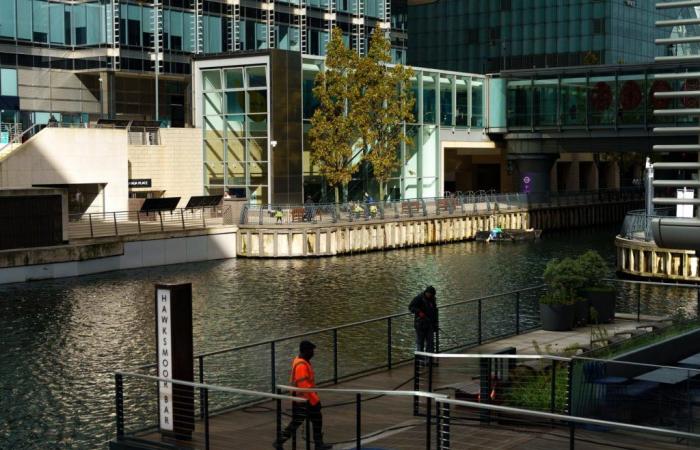The pyramid that adorns the top of One Canada Square, the iconic tower of Canary Wharf, London, blinks faintly under the rainy sky. Right next door, a building adorned with the HSBC logo is only partially lit. The building allocated to Citibank is being renovated. At the foot of these blue glass worlds, a few workers queue in front of a collection of food trucks.
“There are only people from Tuesday to Thursday, says Alex, a 39-year-old banker. Other days, it feels like working in a deserted concrete jungle. » Rosa-Maria, who runs a shop selling fresh pasta, has chosen to adapt her opening hours. “I close at 2:30 p.m. because there is no one there in the evening”she confides.
Also read (2015) | In London, Qatar buys the Canary Wharf business district
Add to your selections
Canary Wharf, a financial district nestled in an inlet of the Thames, was created in the late 1980s on the initiative of Margaret Thatcher, who wanted to revitalize the old docks. Developed by Canadian real estate mogul Paul Reichmann, it was taken over in the mid-1990s by Canary Wharf Group, an entity owned by Qatar’s sovereign wealth fund and asset management company Brookfield.
“There is no other example in Europe of a financial district dominated by a single actor”underlines Marie Dormeuil, real estate specialist at Green Street. Canary Wharf Group alone owns 47% of the buildings in this area, representing an area of more than 715,000 square meters.
Development of teleworking
Recently, however, the group has encountered difficulties. In mid-September, the Fitch agency downgraded the rating of its debt to the “speculative” category, fearing that it would struggle to refinance a debt of 4.2 billion pounds sterling (5 billion euros), part of which expires in 2025 and 2026. “The rise in interest rates in the United Kingdom has increased the cost of debt while causing a devaluation of its real estate assets”explains Mme Dormeuil. In 2023, the value of its property portfolio will lose 1.2 billion pounds, to 6.8 billion pounds.

In parallel, the firm suffered an exodus. HSBC will abandon its 45-storey tower in 2027, in favor of a smaller office in the City. Law firm Clifford Chance will follow in 2028. Moody’s and Credit Suisse have also announced plans to decamp, while Barclays and Citigroup will reduce their footprint. However, in March, the vacancy rate already stood at 15.2%, according to the real estate company CoStar.
Also read (2020) | Article reserved for our subscribers In London, the City transformed into a ghost district
Add to your selections
Canary Wharf has suffered from the development of teleworking since the Covid-19 pandemic. In London, employees spend on average 2.7 days per week in the office, compared to 3.5 days in Paris and 3.1 days in New York. “This forced financial institutions to reduce their office spacenotes Peter Bishop, urban planner at University College London. In this context, the City, a more lively and accessible district, appears to be a destination of first choice. »
You have 43.98% of this article left to read. The rest is reserved for subscribers.








